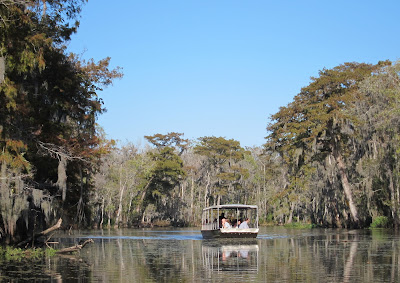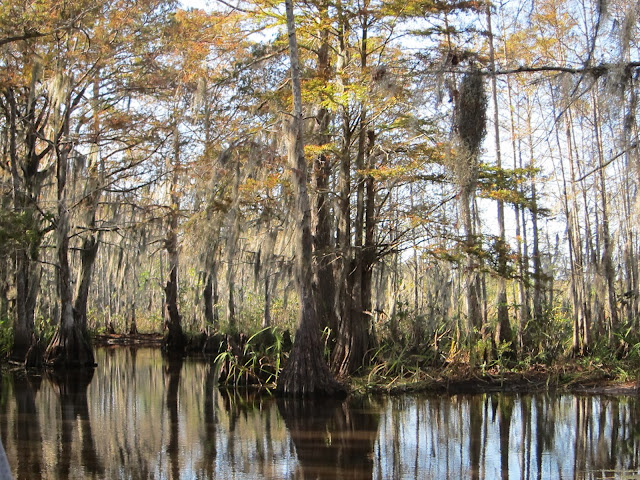Royal Street
Welcome to the city of jazz! New Orleans is a really exciting place to visit. The French Quarter constitutes the headquarters for tourists. Every block you pass echoes a live band while the colorful bright-buildings with iron balconies are simply amazing.
Steamboat Natchez on the Mississippi River,
another landmark of the city
We took the opportunity of attending a jazz concert in a mythical auditorium, the Snug Harbor Jazz Bistro, and saw the Quartet of Ellis Marsalis, the patriarch of a famous family of musicians from New Orleans.
New Orleans still presents a large variety of its historic architecture: French colonial, Spanish colonial like Napoleon House, etc. The district called Marigny which used to be part of the Marigny plantation presents examples of Creole cottages and shotgun houses where every room is just in a line. They are built like that for air flow during the long scorching months.
Napoleon House
Creole style house
Creole food at the French Market
The Garden district is supposed to present a more American style in opposition to the French quarter. The splendid mansions of local notables take up Greek Revival and Italianate elements.
House featured in The Curious Case of Benjamin Button
******
New Orleans is used to hurricane. Flood gates, levees and concrete walls along the canals are part of the landcape. Our hosts told us that three or four times every year, the TV channels advice the inhabitants to leave the city because of an hurricane arriving. But nobody had ever seen what happened in August 2005. The hurricane Katrina arrived along the Gulf of Mexico north coasts. New Orleans' levees broke open. Fifty ruptures occurred in the Federal Flood Protection System and the city was flooded by the canals. The water entered the city to the point its level was even with the level of Lake Pontchartrain. Once the levees were closed again, the water had to be pumped back into the lake. It took several weeks.
About a third of the population of the city did not come back. One of the changes in New Orleans after Katrina is the raise of the hispanic community which came to work in the reconstruction field. As to its previous inhabitants, some came back, others not. We even met a girl who had lost everything during the hurricane, went to San Diego and came back to settle in New Orleans only one month ago.
This house shoved further in the street
The city and the levees were rebuilt to the condition they were before. The parts that broke were fixed but nothing was further fortified. In some street of New Orleans can still be seen empty houses with barricaded doors and windows. Some of them are tagged with rescue-worker code, listing clockwise: the date that the house was cleared, the "hazards" like if there are any dead animals or gaz leaks in the house, the number of dead people and the number of the unit which inspected the house.
People are still rebuilding their houses. New neighborhoods are erected by non profit organizations like Habitat for Humanity or the Make it Right Foundation impulsed by Brad Pitt. For example, a Musicians' Village has been constructed to attract musicians back into the city.
Musicians' Village
Make it Right Project
*****
A very popular attraction around New Orleans: a tour in the swamp! We went on a boat around Honey Island through the bayous. The wildlife there is wonderful. We saw small alligators, a family of hungry raccoons, a water snake and some birds. And the fall colours create a magic scenery.
Our guide and Bryan the Alligator
Raccoons
******
A few miles from New Orleans, one can also visit old plantations, huge farms that mainly worked with slave work, an important part of Louisiana History. Those plantations were growing sugar cane, indigo and so on. Destrehan plantation was established in 1787. The majestic white-pillared mansion watches over the bank of the Mississippi River.

Destrehan Manor House
Slave House on Destrehan property
******
Participate to the Couchsurfing community is a great way to meet local people. In New Orleans, we were hosted by two wonderful ladies in their fourties. They had been traveling in Asia this year for some months and we had a lot of backpackers stories to share. Phyllis and Gina were also eager to talk about their home city, their experience with Katrina and ready to answer to all our numerous questions. They drove us around the city, offering us a priceless encounter with New Orleans.























Hello les jeunes,
ReplyDeleteJ'adore vos photos ! Elles sont trop chouettes. Les couleurs, les maisons, les musiciens... Ca donne vraiment envie !!!
On a l'impression qu'on pourrait chanter dans les rues. Vraiment, il y a une vraie ambiance.
Gros bisous à vous deux
Tata
Trop bien, j'ai trop envie d'y aller. Les maisons créoles sont aussi jolies que dans les caraïbes! Ca se sent que vous avez passé de bons moments là-bas, c'est COOOOOOL !
ReplyDeleteGros bisous et à bientôt pour le prochain numéro.
Claire
Merci à vous deux! On a beaucoup aimé la Nouvelle Orléans. Peut-être retrouvera-t-on la même ambiance en nous dirigeant vers le sud? :))
ReplyDeleteBisous